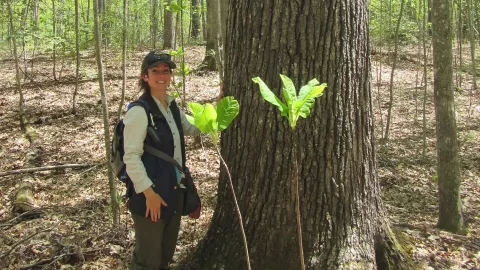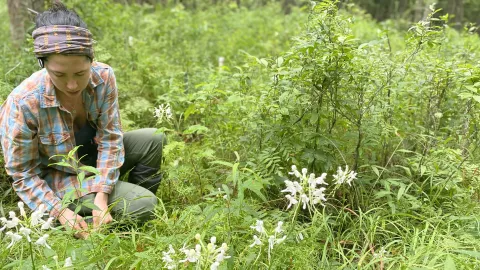White Fringeless Orchid
White Fringeless Orchid
Published on November 1, 2023

Forests are often managed to enhance the quality of timber, wildlife habitat, or ecosystem services. However, in some cases, forest management is focused on improving the understory. This is the case with a long-term research project involving FNR, the Kentucky Office of Nature Preserves, and the U.S. Forest Service. The project aims to restore habitat for a rare orchid species, the white fringeless orchid (Platanthera integrilabia), in southeastern Kentucky.
Many forests of the eastern United States were historically maintained as woodlands through fire and foraging of megafauna. The woodlands contained canopy openings that allowed grasses, wildflowers, and other herbaceous and shrubby vegetation to thrive. With fire suppression and loss of key wildlife foragers, many woodlands have succeeded to closed-canopy forests at the expense of the herbaceous understory community.
Forest and Natural Resource Sciences doctoral students Tara Littlefield and Megan Buland are performing research to help bring back the white fringeless orchid (WFO) at several wetland sites in the Daniel Boone National Forest. Littlefield serves multiple roles with the project, from project coordinator to student. For over 15 years, as the state botanist and federally listed plant recovery lead for Kentucky, Littlefield has worked on status assessments and coordinated recovery efforts for the orchid.

“In my coordination role, I network with partners across the orchid’s range and coordinate monitoring, management, research, and restoration efforts. My research focuses on WFO population response to climatic variation, disturbances, and restoration management activities,” said Littlefield.
Buland’s research focuses on isolation and molecular detection of the WFO fungal symbiont. “Orchids have close symbiotic relationships with mycorrhizal fungi, which are critical for successful development and growth of orchid populations. To ensure successful restoration of WFO, testing to determine the presence of this fungus at restoration sites is critical,” said Buland.

By better understanding the ecology of the orchid mycorrhizal fungi, Buland’s work will help guide the long-term conservation and restoration of this native orchid species. Together, the research efforts have direct implications for evaluating the success of management actions with the goal of developing best management practices for restoring this federally threatened orchid and its wetland habitat across the southeastern United States.
Article by Tara Littlefield and Megan Buland, FNRS Ph.D. Students
